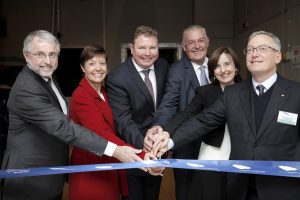
The Ingham Institute’s MRI-Linac Research Bunker is an Australian first and one of just four in the world.
It combines an MRI scanner with a Linear Accelerator for research into cancer therapy and treatment – technology that is set to improve the precision and accuracy of radiotherapy.
And it also means the South West Sydney region leads the world in the treatment of cancer.
The bunker was officially opened on Monday by Craig Laundy, assistant federal minister for industry, innovation and science.
Mr Laundy did the honours on behalf of health minister Greg Hunt, who sent this message:
“I commend the institute’s health and medical research in cancer, diabetes, stroke and cardiovascular disease, urban and Indigenous health, injury and rehabilitation and mental health.
“Innovative health and medical research is a key driver of better healthcare and service delivery,’’ Mr Hunt said in the statement for the official opening of the Ingham research bunker.
“Australia’s excellent research reputation is world-class and has been nurtured by institutes such as Ingham and their developments in applied medical science, such as the MRI-Linac Cancer Program,” he said.
The Federal Government and Australian Cancer Research Foundation (ACRF) provided funding and support for the establishment of the bunker.
The chief executive of ACRF, Prof Ian Brown, said at the official opening:
“ACRF is dedicated to funding research in Australia that has the power to make significant breakthroughs in cancer diagnosis and treatment.
“The projects selected by ACRF for research funding are cutting edge and globally competitive.
“Ingham’s MRI-Linac exemplifies the type of state-of-the-art technology that attracts ACRF’s support and ongoing investment in the pursuit of ways to prevent or more effectively treat cancer.”
Prof Michael Barton, a research director at the Ingham Institute said:
“South West Sydney is rapidly becoming the world centre of development of this pioneering cancer treatment technology; it is the next generation in cancer treatment as it will improve the effectiveness of cancer treatment for patients in our community, Australia and around the world.”
The latest report from South Western Sydney Local Health District Cancer Services showed that the number of cancer patient visits across the district rose from 97,415 in 2011/12 to more than 131,474 in the past year, more than a 25 per cent increase.

